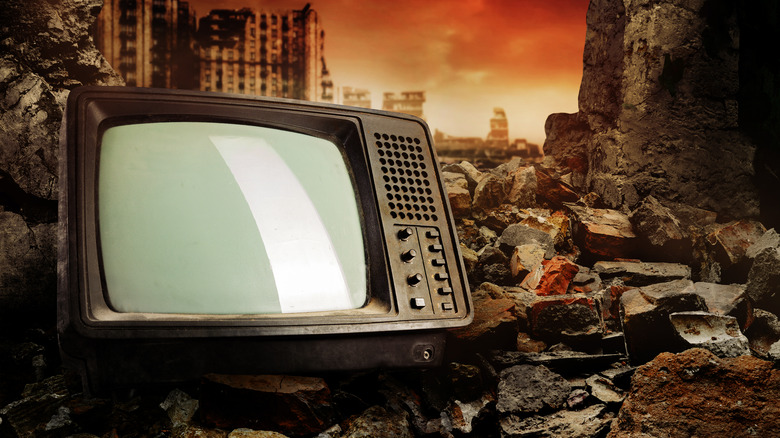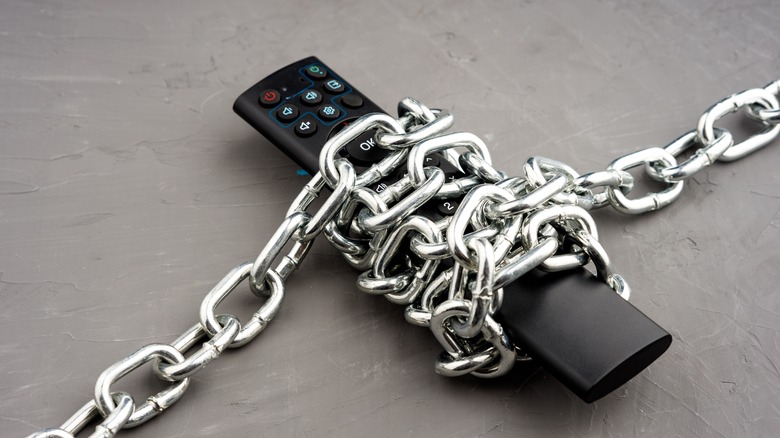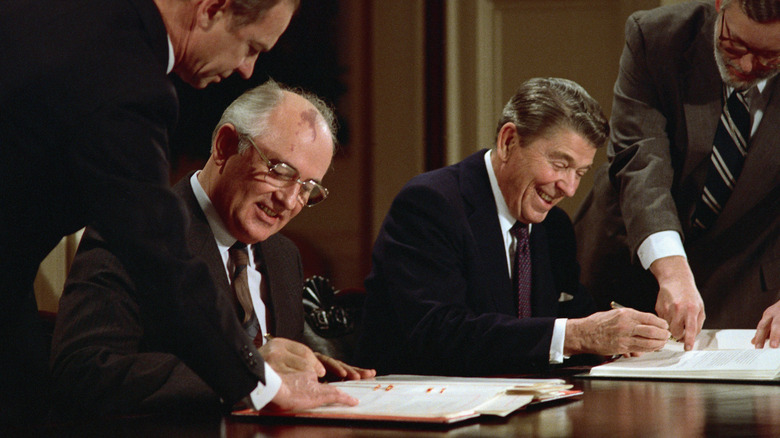The Movie That Helped Prevent A Nuclear Apocalypse During The Cold War
At this point there are so, so, so (so many more so's) many nuclear apocalypse movies that nuclear apocalypse movies are an entire sub-genre of film. IMDb has a Top 20 list of such films, including classics like 1968's "Planet of the Apes" and 1991's "Terminator 2: Judgement Day." In general, post-apocalyptic films range from the ultra-realistic "The Road" to the desert-and-dune-buggy action-absurdity of "Mad Max." And with so many offerings on the table, all of them ultimately conveying the same idea — "Hey, let's not do this nuclear war thing, alright?" — could one film possibly stand above the rest as having moved people enough to actually deter an actual nuclear conflict?
In this case, the movie didn't need to move society. It just needed to move one person: President Ronald Reagan. As CNN says, Reagan watched the movie in question — 1983's "The Day After" — weeks before it aired on television. It left him shaken, "greatly depressed," and committed to nuclear deterrence. "My own reaction," he wrote in his diary, "was one of our having to do all we can to have a deterrent & to see there is never a nuclear war." This came at a time of high tension between the United States and the Soviet Union, when folks were scared that bombs might drop any day. Ultimately, it's a bit of an overstatement to 100% attribute the lack of nuclear war to a made-for-TV movie. But, it seems like "The Day After" did help steer events towards peace.
Fears about the film before it aired
To say that 1983's "The Day After" was a nationwide phenomenon is a dramatic understatement. It garnered 100 million viewers at the time it aired. That's a wild number exceeded only by various Super Bowls, the final episode of M*A*S*H*, President Nixon announcing his resignation, and the 1969 moon landing (via TV Insider).
As USA Today explains, "The Day After" got so much attention in part because of so many people advocating caution about watching it. Media screenings came with written guidelines "to help people prepare for the experience." At the time, The New York Times reported that the National Association of Independent Schools recommended that children see the movie, "with their families or in similarly supportive surroundings." The nuclear war educational group Ground Zero said that children under 12 should be banned from seeing the movie. People could even call a phone number during the movie and talk through their feelings about it. Meanwhile, The New York Times also reports that conservative magazines like Human Events decried the film as anti-nuclear propaganda.
This reaction might come across as overblown. It also helps explain how interest in "The Day After" reached a fever pitch by the time the film aired on November 20. Media outlets got in on the hype, too. In a full-page ad TV Guide wrote, "They told us it would be impossible to make this movie. They told us it would be impossible for you to watch it. We hope nothing is impossible," per USA Today.
A harrowing portrayal of nuclear war
"The Day After" was billed as an overwhelmingly grim, terrifying, and harrowing portrayal of nuclear war and its ground-level aftermath experienced in small-town America. Non-critic reviews on IMDb ranging all the way from 1998 to the present describe the film as "nightmarish," "disturbing," "bleak," "shattering, utterly horrifying," and more. Other takes are more lukewarm or come at the film from an acting or technical angle. Critics were impressed with the film, too. TV Critic Tom Shales wrote in The Washington Post, "Everyone should watch it. Who will be able to forget it? No one will be able to forget it."
Even though "The Day After" was a made-for-TV movie it does come with a Hollywood pedigree. "Star Trek II: The Wrath of Khan's" Nicholas Meyer directed it, and set it in his own small hometown of Lawrence, Kansas. Yes, "The Day After" has special effects of bombs going off, silos shooting missiles, flames enveloping people, and so forth — particularly in a prolonged, highly unsettling 11-minute sequence. But, the overall focus is more on geopolitics and public sentiment leading up to the movie's nuclear attack. That, and the fallout of smoldering buildings, streets saturated with broken bodies, and actor Jason Robards poking through the devastation. The movie also didn't show whether the U.S. or Soviet Union shot the first missile.
Those curious about watching "The Day After" don't have to try hard. The whole thing, beginning to end, is available on YouTube.
Steering the course of history
Not even the president of the United States escaped the tide of interest in "The Day After," or the film's impact. Ronald Reagan watched the film at Camp David weeks before it aired to the public. He found it so disturbing that he asked for certain parts of the film to be edited before it hit network TV. Before that the U.S. Department of Defense had loomed over the script and production. To ABC's credit, though, they didn't cut anything from the film and aired it in the same two-hour form as when Reagan watched it.
We mentioned that "The Day After" greatly moved Reagan, and he wrote so in his diary. Two months later on January 25, 1984, Reagan talked plainly about nuclear deterrence in his State of the Union address, readable in full on the National Archive. "People of the Soviet Union," he said, "there is only one sane policy, for your country and mine, to preserve our civilization in this modern age: A nuclear war cannot be won and must never be fought."
While it's a stretch to say that Reagan's feelings arose solely from "The Day After," it's reasonable to assume that the movie helped inspire his policies from that point forward. Over three years later on December 8, 1987, Reagan and Soviet General Secretary Mikhail Gorbachev signed the Intermediate-Range Nuclear Forces (INF) Treaty to greatly reduce their stockpiles of nuclear weapons, effectively bringing the Cold War's greatest fears to an end.


